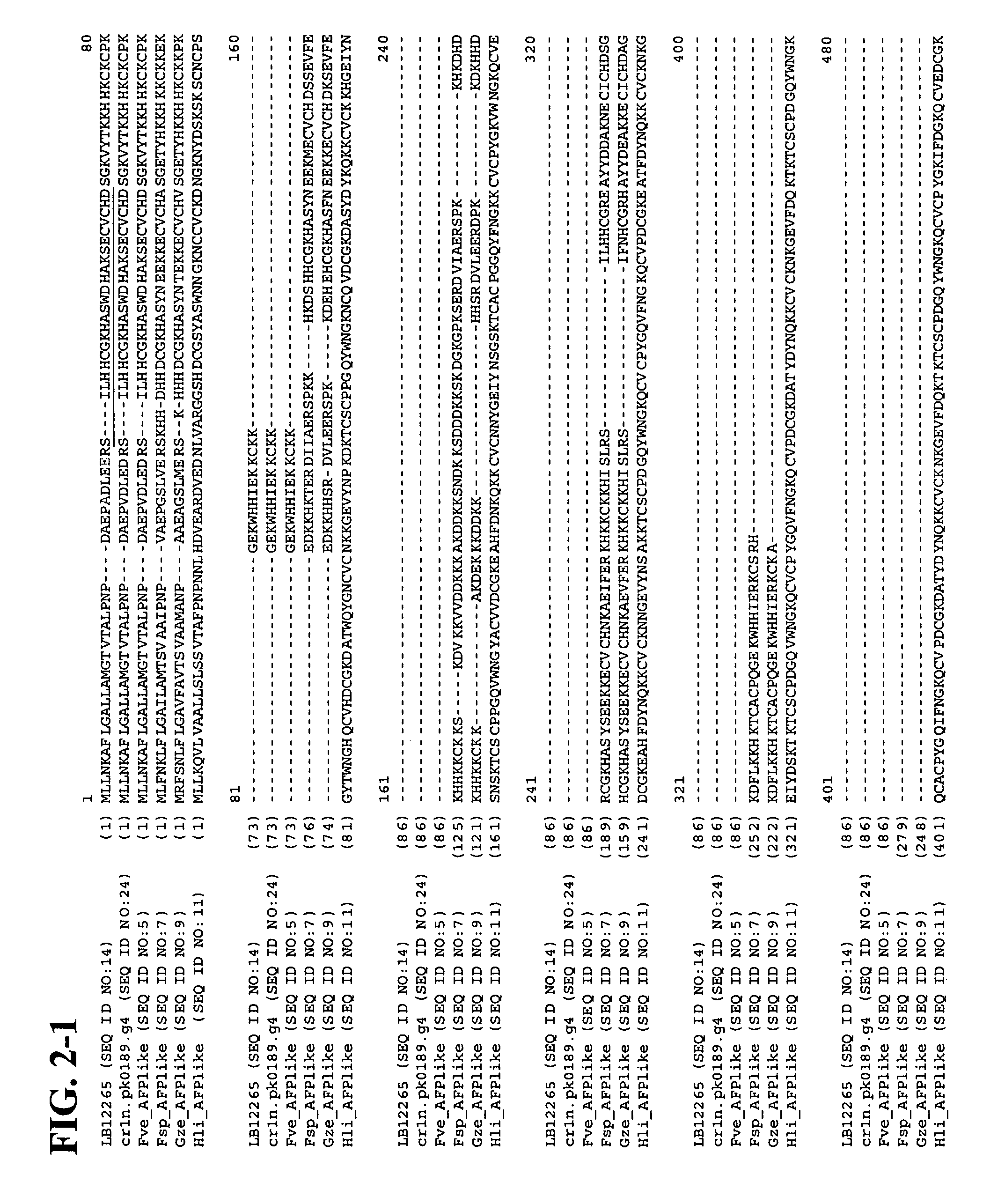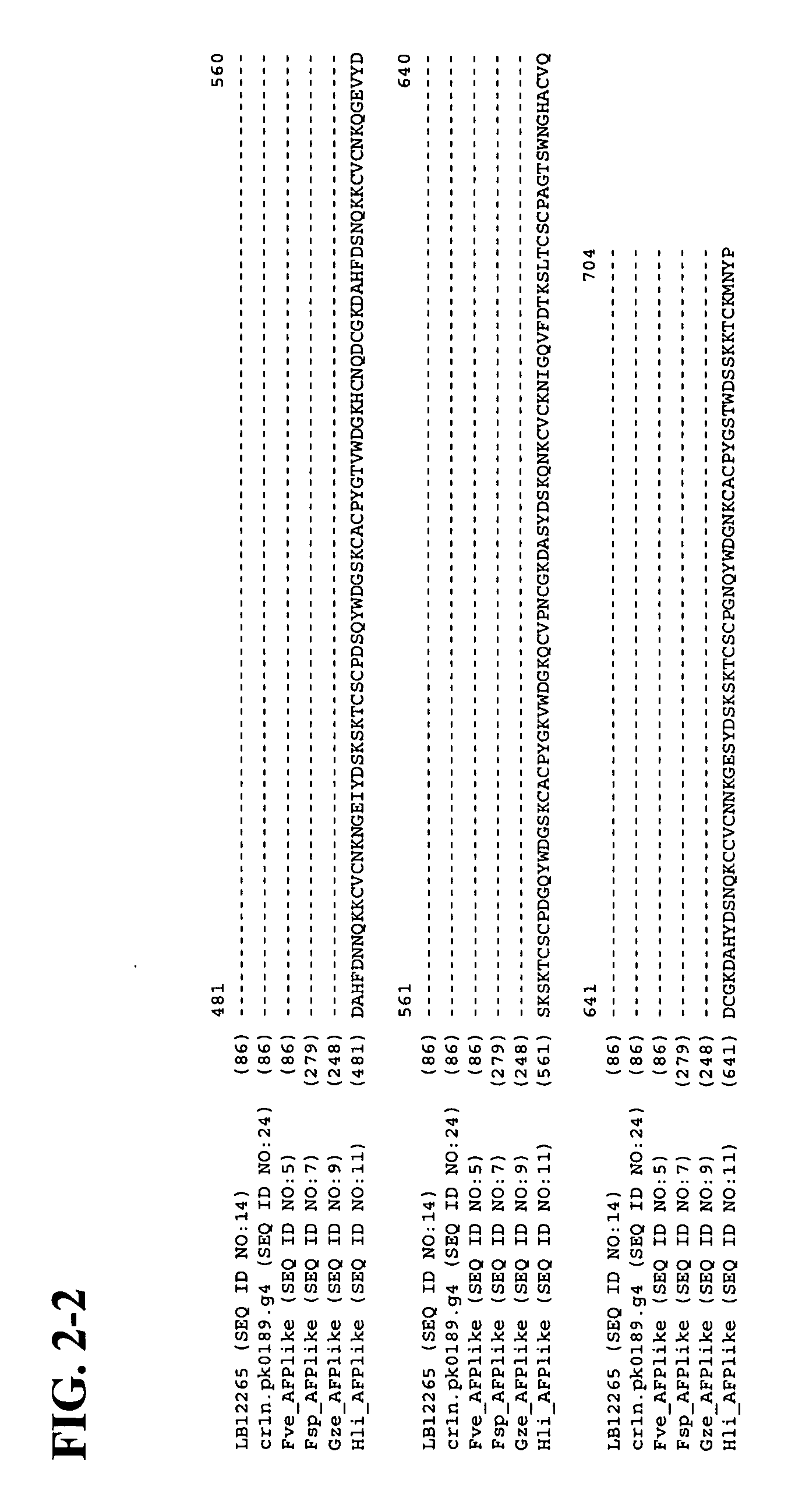Antifungal polypeptides
- Summary
- Abstract
- Description
- Claims
- Application Information
AI Technical Summary
Benefits of technology
Problems solved by technology
Method used
Image
Examples
example 1
Isolation of Antifungal Polypeptide LB-12265 (SEQ ID NO:1)
[0135] An environmental sample was collected from the rhizosphere of the wildflower Dianthus barbatus L. (common name sweet William) in the Kiev region. The organism, denoted herein as IMV 00113, that produced the antifungal polypeptide SEQ ID NO:1, was isolated using potato dextrose agar. The strain was later identified as Fusarium oxysporum Schlecht emend. Synd. et Hans. Molecular-level identification of the strain is still pending. The pure culture of the organism has been maintained at room temperature on malt extract agar slant by sub-culturing it in regular intervals. Isolate IMV 00113 was transferred to Berkeley Lab where the cultures were grown on PDA and preserved by placing 10 agar plugs per strain sampled with sterile P1000 plastic tips into 2 ml cryotubes containing 0.7 ml 45% (w / v) sterile glycerol. The cryotubes then were placed in a wooden block and frozen overnight in a −20° C. freezer at an approximate freez...
example 2
Antifungal Activity of Polypeptide LB-12265 (SEQ ID NO:1)
[0146] The antifungal activity of the polypeptide of SEQ ID NO:1 against the fungal pathogens Fusarium verticillioides (FVE), Colletotrichum graminicola (CGR), Fusarium graminearum (FGR) and Diplodia maydis (DMA) was assessed using a standard plate assay.
Preparation of Cultures for Spore Production:
[0147] Cultures of FVE were prepared using V8 agar plates. FGR, CGR, and DMA cultures were prepared using ½× oatmeal agar. Media recipes are provided below.
[0148] Specifically, tubes containing silica-gel fungal stocks stored at −20° C. were briefly flamed, and approximately 5 crystals were sprinkled onto the agar surface. 2-3 plates of each fungal isolate were prepared. The newly plated cultures were stored in a plastic box to prevent the cultures from drying out. FVE cultures were grown in the dark at room temperature. CGR cultures were grown in ambient light at room temperature. FGR and DMA cultures were grown in an illumina...
example 3
Isolation of Full-Length LB-12265 Gene from Genomic DNA
[0160] PCR was performed to isolate the full length LB-12265 gene from genomic DNA. The following materials were used in this process:
Materials Used
[0161] FastStart Taq DNA Polymerase Kit (Roche cat. # 12032937001) [0162] Hot Start Micro 50 Reaction Tubes (Molecular BioProducts cat. # 6310) [0163] PTC-100 Thermal Cycler from MJ Research, Inc [0164] dNTP's (Roche cat. # 1277049) [0165] Formamide (J.T. Baker cat. # 4028-00)
Template and Primers
[0166] LB-12265 genomic DNA at a concentration of approximately 0.2 ug / μL was used as the template for the PCR reactions. Two primers were designed to the peptide sequence.
Sense Primer 932295′-CCATCAGGATCCGGCGGCCATGCTTCTCAACAA(SEQ ID NO:32)GGCTTTCCTCGGCAnti-Sense Primer 932315′-CGTTGTGATATCTCACTTCTTGCACTTCTTCTC(SEQ ID NO:33)AATGTGGTGCCACTTC
PCR [0167] Lower and upper reaction mixtures were prepared as described below: [0168] Lower: 36.3 μL dH2O, 5.5 μL of 10× (+MgCl2) PCR Buffer, 2.2...
PUM
| Property | Measurement | Unit |
|---|---|---|
| Fraction | aaaaa | aaaaa |
| Temperature | aaaaa | aaaaa |
| Temperature | aaaaa | aaaaa |
Abstract
Description
Claims
Application Information
 Login to View More
Login to View More - R&D
- Intellectual Property
- Life Sciences
- Materials
- Tech Scout
- Unparalleled Data Quality
- Higher Quality Content
- 60% Fewer Hallucinations
Browse by: Latest US Patents, China's latest patents, Technical Efficacy Thesaurus, Application Domain, Technology Topic, Popular Technical Reports.
© 2025 PatSnap. All rights reserved.Legal|Privacy policy|Modern Slavery Act Transparency Statement|Sitemap|About US| Contact US: help@patsnap.com



